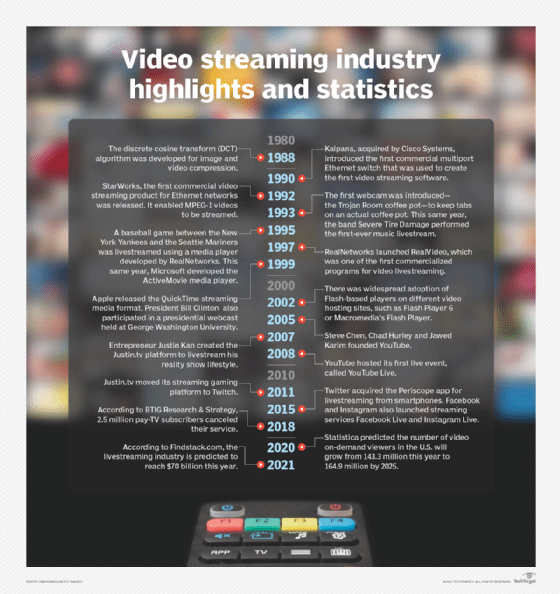video streaming
What is video streaming?
Video streaming is a continuous transmission of video files from a server to a client. Video streaming enables users to view videos online without having to download them.
Streamed video content can include movies, TV shows, YouTube videos and livestreamed content. Services such as Netflix and Hulu have had great success in streaming videos to subscribers.
The term streaming refers to the continual transmission of audio and video files from a server to a client. In video streams, content is sent in a compressed form over the internet and is displayed by the viewer in real time. The media is sent in a continuous stream of data and is played as it arrives. The user needs a player, which is a special program that uncompresses and sends video data to the display and audio data to speakers. Examples of media players include Windows Media Player 12 for Windows 10 or QuickTime Player for MacOS.
How does video streaming work?
Video streams normally begin with a prerecorded media file hosted on a remote server. Once the server receives a client request, the data in the video file is compressed and sent to the requesting device in pieces. Audio and video files are broken into data packets, where each packet contains a small piece of data. A transmission protocol, much of the time either Transmission Control Protocol (TCP) or User Datagram Protocol (UDP), is used to exchange data over a network. Once the requesting client receives the data packets, a video player on the user end will decompress the data and interpret video and audio. The video files are automatically deleted once played.
TCP is typically the more reliable protocol; however, UDP has a faster transmission time. UDP is used when speed takes precedence over reliability, while TCP is used when reliability takes precedence. Many consumer streaming services use TCP, for example, while UDP is well suited for video conferencing.
Video streams are usually sent from a prerecorded video file, but they can also be distributed as part of a live broadcast feed. In a live broadcast, the video signal is converted into a compressed digital signal and transmitted from a special web server that multicasts, or sends the same file to multiple users at the same time.
Users can stream from their desktop computers, smartphones, tablets and smart TVs, or through other devices such as Chromecast or Apple TV. Different applications can be used to stream video such as YouTube, Netflix, Amazon Prime Video, Disney+ or Twitch. Services such as YouTube stream videos for free and are ad supported, while services such as Netflix are supported by a user subscription model.
Video streaming also requires a high enough speed for the best performance. Less data is needed to stream lower video quality, but higher video quality, such as 1080p – which features a progressive scan display -- or 4K needs faster data speeds to play smoothly.
Although a small portion of TV shows broadcast up to 1080i -- which uses an interlaced display -- most programs are broadcast over the air with the primary definition set at a standard of 720p, a resolution that YouTube no longer considers high definition. By comparison, streaming services such as Netflix and YouTube offer video resolutions of up to 2160p, which is 4K.
Benefits of video streaming
Video streaming offers the following advantages.
- Downloading vs. streaming. Users can view videos without having to download them.
- High playback resolutions. Some services support up to 4K, which is a higher quality than the standard for over-the-air TV resolution.
- Price. Some video streaming services such as YouTube and Twitch can be used for free, while other streaming services rely on subscription models that may cost less than the average cable subscription.
- Platform choice. Users can choose from a number of platforms to stream videos. TV and movie streaming services typically try to compete with one another by making exclusive content. Users can view livestreamed content as it happens, while they can view on-demand content, which is prerecorded media, whenever they want.
- Content variation. Since the concept of video streaming is so broad, individuals can stream TV shows, movies, user-generated content from websites like YouTube, or livestream content online.
Video streaming challenges
The concept of video-streamed content does come with its own challenges, however. These include:
- Lack of bandwidth. The higher the quality of the video, the more bandwidth is needed to support the streaming of that data. If several devices use a large amount of data at the same time, there may not be enough bandwidth to stream higher content in 4K or other high qualities.
- Slower performing client devices. If a device is older, is slowed down due to programs not being optimized for it or has too many processes running at once, video streams may also begin to slow down or drop out.
- Copyright. Users of video streaming content -- especially livestreamed content -- must be aware of restrictions on copyrighted content such as music appearing in their stream. This is a major issue on user-generated content platforms such as YouTube and Twitch.
- Network latency. On the network side, the location of the clients and servers can affect latency. The farther away the client and server are, the greater the distance the data must travel.
Reasons for buffering
Another challenge for video streaming involves buffering. Buffering is the process a media player uses to load a video stream a few seconds ahead of time. This helps to ensure there is no lag in the stream and the video can keep playing if service is briefly interrupted. If a network connection is slow enough, or if service is interrupted long enough, the video will stop playing while buffering continues to occur.
In addition, if a router is too slow to send video data to a device, then the video will buffer. Upgrading the router and internet speeds can help prevent this and improve a user's streaming experience.
Difference between downloading and streaming
The main difference between downloading and streaming video is that streaming is a continuous transmission of video files in real time. Video streaming can also include livestreamed content, which is content that is currently being produced. The video is not copied and saved; instead, once streamed, the data is deleted.
Downloaded content cannot be played while it is being downloaded. Instead of loading and buffering small amounts of the video at one time, downloaded video files are loaded all at once.
History of video streaming
It was not until the late 1980s that consumer PCs had enough power to display streamed media. Up until this time, nonstreaming methods such as CD-ROMs were used.

1988: The base for the first practical video coding format, the discrete cosine transform (DCT) algorithm, was developed for image and video compression.
1990: The first commercial Ethernet switch was developed by Kalpana, which was later purchased by Cisco Systems. This switch helped to create the first video streaming software.
1992: The first commercial video streaming product, called StarWorks, was released. It was developed for enterprise Ethernet networks and enabled MPEG-1 videos to be streamed.
1993: The Trojan Room coffee pot became the first livestreamed content with a webcam; initially put on the internet in 1991, this live picture of a coffee pot let others in the Computer Lab at the University of Cambridge in England know when the coffee machine was empty. This began the livestreaming of more and more virtual events.
Also, in 1993, the band Severe Tire Damage performed the first-ever music livestream. The band was made up of various engineers and computer scientists who decided to livestream their music.
1995: RealNetworks developed a media player capable of livestreaming a baseball game between the New York Yankees and the Seattle Mariners. That same year, Microsoft developed the media player, ActiveMovie, which was the precursor to Windows Media Player 6.4.
1997: RealNetworks launched RealVideo, which was one of the first commercialized programs for video livestreaming.
1999: Apple released a streaming media format called QuickTime. That same year, President Bill Clinton participated in a presidential webcast held at George Washington University.
2002: There was widespread adoption of Flash-based players on different video hosting sites, such as Flash Player 6 or Macromedia's Flash Player. The early 2000s also offered improved protocol formats such as Transmission Control Protocol/Internet Protocol (TCP/IP), HyperText Markup Language (HTML) and HyperText Transfer Protocol (HTTP).
2005: YouTube was founded by Steve Chen, Chad Hurley and Jawed Karim. It initially used a Flash-based player, but later moved to HTML5.
2007: The streaming platform Justin.tv was released. It would eventually become the popular Amazon-owned livestreaming service, Twitch.
2008: YouTube hosted its first live event, called YouTube Live. Today, creators who have more than 1,000 subscribers on their channel can livestream on mobile devices.
2011: Justin.tv moved its streaming gaming platform to a new site called Twitch. Just two years later, the platform had more than 45 million viewers per month. In 2014, Twitch was renamed Twitch Interactive and purchased by Amazon. Currently, Twitch has 140 million unique monthly users, according to Mediakix.
2015: Twitter acquired the livestreaming app Periscope. Facebook and Instagram also began acquiring and launching their own livestreaming services. The Twitter livestreaming service Periscope shut down on March 31, 2021.
2018: According to BTIG Research & Strategy, 2.5 million pay-TV subscribers cut the cord, hitting providers such as AT&T and Dish Network hard.
2020: Market and consumer data analyst Statistica predicted that the number of video on-demand viewers in the U.S. will grow from 143.3 million in 2020 to 164.9 million by 2025.
2021: According to business-to-business software search firm Findstack, the livestreaming industry is predicted to reach $70 billion this year and grow to $223.98 billion by 2028.
Popular video streaming services today include:
- Amazon Prime Video
- Apple TV+
- Crunchyroll
- Disney+
- HBO Max
- Hulu
- Netflix
- Peacock
- Twitch
- YouTube
YouTube, in particular, has become such a massive video streaming platform that it is now, according to Forbes, the world's second-largest search engine, with up to 3 billion searches per month. As a search engine, YouTube is second only to Google. So much content is posted to YouTube that if someone were to try watching every video on the platform, they would fall behind more than 300 hours every minute. That is the equivalent of falling behind more than a week and a half every single minute.
Learn more about video livestreaming's growth during the COVID-19 pandemic.







